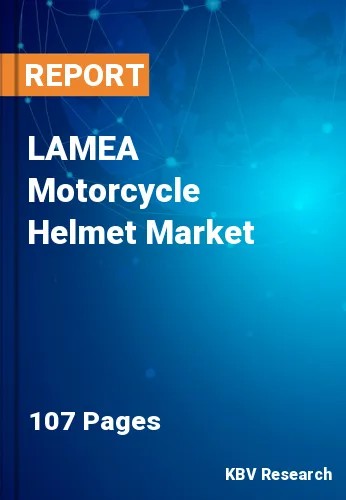The Latin America, Middle East and Africa Motorcycle Helmet Market would witness market growth of 7.3% CAGR during the forecast period (2023-2030).
Due to the increasing number of young and middle-class people, motorcycles have become the most common two-wheeled vehicles. A person who buys a motorcycle no longer has to depend on public transportation and can get where they're going more quickly. The desire for motorcycles is primarily driven by men who use these cars to swiftly navigate traffic. As a result, there is an increase in the use of motorcycle helmets, which is closely correlated with two-wheeler sales.
The significance of wearing helmets is emphasized in government safety initiatives as well as motorcycle rider education programs. These programs affect consumer behavior and encourage the adoption of helmets. The adoption of helmets has increased due to shifting views about safety, especially among city commuters and younger riders. More people now consider helmets to be stylish, responsible accessories. The World Health Organization (WHO) has published a new guidebook to help governments promote the usage of motorcycle helmets.
Growing urbanization in many African countries has increased congestion and city traffic. As a result, motorcycles and scooters have become popular modes of transportation due to their maneuverability in congested urban areas. This trend has increased demand for motorcycle helmets as riders prioritize safety while navigating busy city streets. The motorcycle helmet industry has responded to the growing demand by introducing innovative designs and features catering to urban riders. Helmets designed for urban use often include improved ventilation, built-in sun visors, and lightweight designs. South Africa has helmet safety regulations that require helmets to conform to the South African National Standards (SANS 2205). Helmets must display the SANS mark to indicate compliance with safety standards.
In addition to daily commuting, there is a growing interest in recreational motorcycle riding in the Middle East. Motorcycle enthusiasts often participate in group rides and events, driving the demand for helmets designed for leisure riding. Some Middle Eastern countries, such as the United Arab Emirates and Oman, have been promoting motorcycle tourism and adventure riding. This has increased the need for high-quality helmets among tourists and riders exploring the region's diverse landscapes.
The Brazil market dominated the LAMEA Motorcycle Helmet Market by Country in 2022, and would continue to be a dominant market till 2030; thereby, achieving a market value of $184.9 Million by 2030. The Argentina market is showcasing a CAGR of 7.9% during (2023 - 2030). Additionally, The UAE market would register a CAGR of 7% during (2023 - 2030).
Based on End-user, the market is segmented into Rider and Passenger. Based on Product, the market is segmented into Full Face, Open Face, Off-road/Racing and Others. Based on Distribution Channel, the market is segmented into Offline and Online. Based on countries, the market is segmented into Brazil, Argentina, UAE, Saudi Arabia, South Africa, Nigeria, and Rest of LAMEA.
Free Valuable Insights: The Worldwide Motorcycle Helmet Market is Projected to reach USD 3.6 Billion by 2030, at a CAGR of 7%
The market research report covers the analysis of key stake holders of the market. Key companies profiled in the report include Dainese S.p.A, HJC Helmets, SHOEI Co., Ltd., Alpinestars, Schuberth GmbH, STUDDS Accessories Limited, Caberg S.p.a., Fox Racing, Inc. (Vista Outdoor, Inc.), Manufacturas Tomas helmets (MT Helmets), and Shark SAS.
By End-user
By Product
By Distribution Channel
By Country
Our team of dedicated experts can provide you with attractive expansion opportunities for your business.

